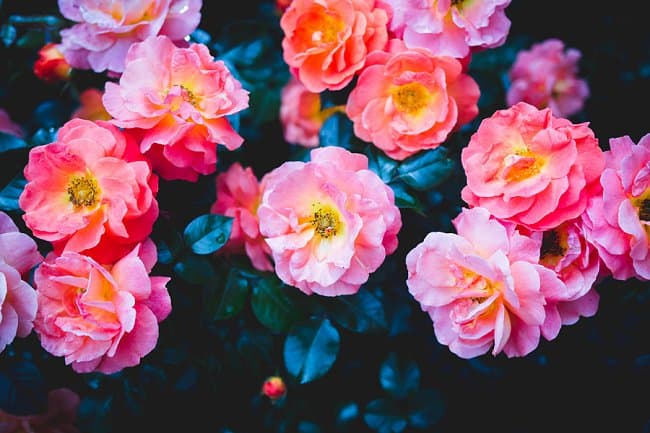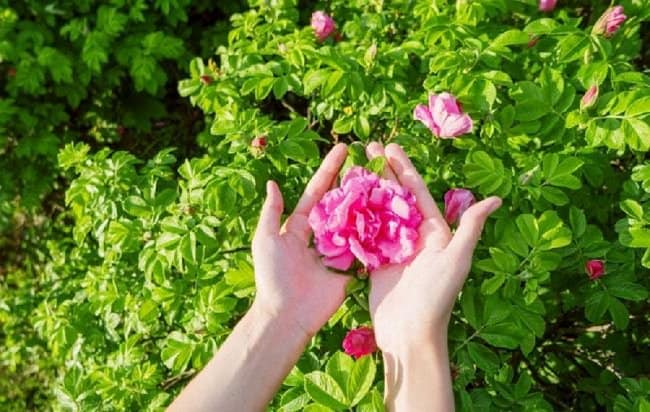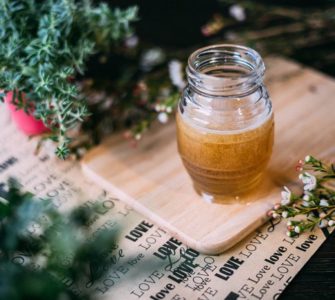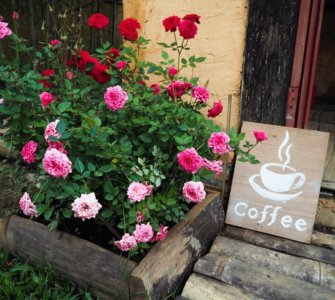Roses aren’t just a beautiful garden addition. They’re also full of vitamins and minerals, so the good news is that yes, absolutely you can eat wild roses! If you want to be safe eating wild roses, you’re going to need to check for pesticides, poisons such as rat poison and / or insecticide, and you’ll want to make sure that you’re eating the best – and tastiest! – parts of the rose plant.
Wild rose are an edible plant through and through. Survivalists will tell you that rose hips are the easiest thing to notice and eat safely due to its bright red color contrasting against the winter snow during a time when not much else grows. First Nations peoples foraged and survived off of the rose hips packed with vitamins and proteins. Herbalists regularly wax poetic about how wild rose is a perfect plant to open the fourth chakra of the heart and heal heavy emotions.
As for us gardeners, well…we just like a rose no matter what shape or form it comes in!
Wild rose is a plant variety brought over a long time ago from Asia. On the Northern hemisphere, it has become somewhat of an invasive species. Only in the Americas, there are over 100 different varieties of wild roses growing across several different countries. You can find them in fields or forests, as they usually prefer dappled shade and moist but drained soil – just like their domesticated counterparts.
Some of the most commonly found varieties are Rosa rugosa and Rosa multiflora. Just about any part of the wild rose bush is edible. You can eat rose flower petals, rose hips and even rose leaves. All wild rose varieties are edible – and this makes perfect sense!
Wild roses are directly genetically related to apples, pears, strawberries, blueberries and other fruits we are used to eating!
Table of Contents
How To Identify A Wild Rose
If you wondering can I eat a wild rose, you’re probably going to need to be sure that what you’re about to eat is in fact, a wild rose. You don’t want to be eating a rose from someone’s garden, or another type of flower, that could turn out to be poisonous!
In case you don’t have a wild rose bush variety growing in the periphery of your own garden that you are 100% sure is a wild rose, it is good to know how to tell the difference between domesticated roses and wild roses. This is straightforward – unlike some other flowers out there or mushrooms, it is really, REALLY hard to mistake a wild rose for anything else.
As Shakespeare famously wrote, “The rose by any other name would not smell as sweet.”
The wild rose really looks like a domesticated rose in miniature and gardeners often say they can be similar in appearance to rose climbers. However, sometimes they can look different to garden and heirloom rose varieties bred for their appearance. There are a few telling ways not to confuse the two, even if you have never encountered a wild rose bush before.
Thorns
The most obvious difference between domesticated and wild roses are their thorns. On a domesticated rose, thorns are usually thicker and tend towards a pyramid shape. There is ample space on the stem where you can hold a domesticated rose, without getting pricked by the thorns as they come few and far between.
However, on a wild rose, take note to have some heavy-duty gloves with you in case you need to take hold of the stem. The thorns are smaller – they are thin, fine, spiky and clustered all over the stem with usually little to no space to safely take hold with a bare hand. Wild rose thorns are often reminiscent of tiny needles, in contrast to thicker domesticated rose thorns.
Leaves
Leaves on domesticated roses and wild roses are usually identical in shape. However, wild roses will have several orders of magnitude smaller leaves. In wild roses, you can also usually find very fine, small and thin thorns on the undersides of the leaves.
Blooms and petals
By far the most telling difference between the two, blooms of wild roses and heirloom roses are drastically different. Heirloom roses, as they are bred for the appearance, have wide, big and luxurious flowers.
This is not the case with the wild roses. When in full bloom during spring or summer months, wild rose yields a small and quite basic flower. Usually, the flowers have only 5 petals, sometimes less and sometimes more, but always an odd number. They can be white, pink, yellow or red in color with a sun-yellow or ochre center. However, the blooms will be every bit as fragrant as in domesticated roses, if not more.
Rose hips
Located right under a bloom, wild rose hips also share some difference to domesticated ones. They look like very small apples – unripe hips are a bright green color while ripe hips tend to take on a red to yellow-red color. Gardeners usually agree that wild rose hips are far more sweet in taste. When purely talking about the appearance, it is of note that wild rose hips, are too, much smaller than the domesticated rose hips. When fully ripened, wild rose hips are usually the reddest of reds, while domesticated rose hips tend to take on an orange color.
Main cane
In addition to the thorniness, the shoots of wild roses tend to be red to reddish-brown in color. This contrasts to green to greenish-brown shoots of domesticated roses.
Edibility of wild roses
All parts of all wild roses are perfectly edible. As long as your wild rose isn’t sprayed, treated with chemicals, inorganic hormones or purchased from the florist, you are good to go! All you need to do is give the petals, rose hips and leaves a little rinse with water to wash out any insects or debris and you can eat your goods straight away!
Can I eat wild rose petals?
Quite a few flowers that occur naturally in the nature are edible. If organic, any rose petals are edible. Wild rose petals are especially edible, considering they are surprisingly pleasantly sweet in taste. Petals can be picked and eaten straight from the plant. If you dislike the strong, zesty flavour, consider cutting off the white part at the bottom of the petals which is the sharpest tasting part.
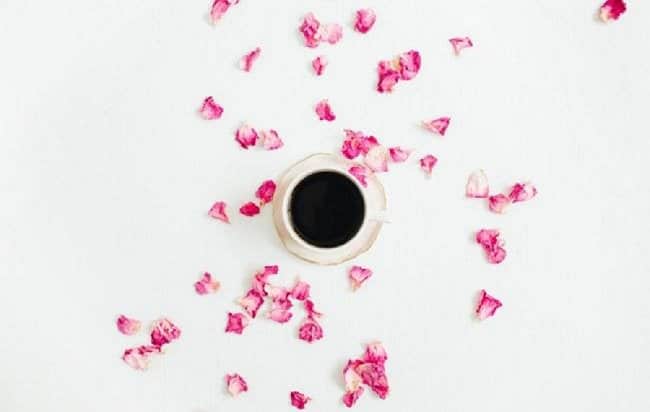
Contrary to popular opinion, red roses usually have a mild fragrance. Therefore, they tend to be less sweet.
For best tasting wild rose petals, choose pink and yellow-flowering wild roses, as they are the best bet for both intense fragrance and sweet flavor.
Can I eat wild roses – what about leaves?
Wild rose leaves, quite surprisingly, are also edible! But you don’t very often hear about rose leaves being edible except for in some teas.
Ideally, you should pick wild rose leaves while they’re still young and small for ideal taste. For a caffeine kick, you can chew or eat them straight off the plant, as they have a slightly bitter taste to them. Usually, the best way to consume wild rose leaves is to keep them for a herbal tea or mix with dried rose hips for a very tasty tea similar to a black tea blend.
Can I eat wild rose hips?
The most wonderfully tasty part of any wild rose – wild rose hips! Ripe wild rose hips are sugary, fruity in taste and high in vitamin C, beta-carotene and malic acid. One tablespoon of wild rose hip pulp contains the amount of vitamin C you can find in five large oranges!
Wild rose hips usually ripen in July and can be found all the way through November. Their taste may vary, depending on the sort of the plant and the time of the harvest. For sweetest rose hips, look to harvest after first frost has passed (usually in November, for Northern hemisphere folks). Harvest it straight off the plant, picking unopened rose hips that are fully ripe and close to opening on the plant. Make sure the hips are red, as greener ones are still a bit young and might taste bitter.
After washing, you can bite straight into your rose hip. For extra sweetness, open the rose hip up and remove the seed pad and hairs inside to leave only the pulp. However – leave the seeds in if you want more protein, as they are packed full with it! Some people say the taste is quite reminiscent of apricots or apples. I can’t think of a better early winter vitamin boost
We hope you enjoyed this post on whether you can eat wild roses. While you absolutely can eat them straight from the bush, our site has tons of better ways to use wild roses. Try this here to start with!

